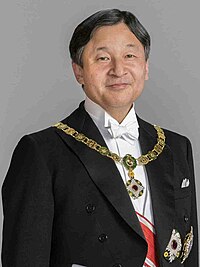| Emperor of Japan | |
|---|---|
| 天皇 | |
Imperial | |
 | |
| Incumbent | |
 | |
| Naruhito since 1 May 2019 | |
| Details | |
| Style | His Majesty[b][c] |
| Heir presumptive | Fumihito |
| First monarch | Jimmu (mythical) Tenmu (First monarch using title "Emperor") |
| Formation | February 11, 660 BC; 2683 years ago (mythical)[a] |
| Residence | Tokyo Imperial Palace (official residence) |
| Website | www.kunaicho.go.jp |
| This article is part of a series on |
 |
|---|
|
|
The Emperor of Japan[d][e] is the hereditary monarch and head of state of Japan.[6][7] The emperor is defined by the Constitution of Japan as the symbol of the Japanese state and the unity of the Japanese people, his position deriving from "the will of the people with whom resides sovereign power".[8] The Imperial Household Law governs the line of imperial succession. Pursuant to his constitutional role as a national symbol, and in accordance with rulings by the Supreme Court of Japan, the emperor is personally immune from prosecution.[9] By virtue of his position as the head of the Imperial House, the emperor is also recognized as the head of the Shinto religion, which holds him to be the direct descendant of the sun goddess Amaterasu. According to tradition, the office of emperor was created in the 7th century BC, but the first historically verifiable emperors appear around the 5th or 6th centuries AD.[10][11]
The role of the Emperor of Japan has historically alternated between a largely ceremonial symbolic role and that of an actual imperial ruler. Since the establishment of the first shogunate in 1192, the emperors of Japan have rarely taken on a role as supreme battlefield commander, unlike many Western monarchs. Japanese emperors have nearly always been controlled by external political forces, to varying degrees. For example, between 1192 and 1867, the shōguns, or their shikken regents in Kamakura (1203–1333), were the de facto rulers of Japan, although they were nominally appointed by the emperor. After the Meiji Restoration in 1868, the emperor was the embodiment of all sovereign power in the realm, as enshrined in the Meiji Constitution of 1889. Since the enactment of the 1947 constitution, the role of emperor has been relegated to that of a ceremonial head of state without even nominal political powers. For example, the emperor is the head of the Japanese honors system, conferring orders, decorations, medals, and awards in the name of the state and on behalf of its people in accordance with the advice of the Cabinet.
Since the mid-nineteenth century, the emperor and other members of the imperial family have resided at the Imperial Palace,[f] located on the former site of Edo Castle in the heart of Tokyo, the current capital of Japan. Earlier, emperors resided in Kyoto, the ancient capital, for nearly eleven centuries. The Emperor's Birthday (currently 23 February) is a national holiday.
Naruhito is the current emperor of Japan. He acceded to the Chrysanthemum Throne upon the abdication of his father, Emperor Akihito, on 1 May 2019. He is the only remaining monarch and head of state in the world who holds the title of Emperor.
Cite error: There are <ref group=lower-alpha> tags or {{efn}} templates on this page, but the references will not show without a {{reflist|group=lower-alpha}} template or {{notelist}} template (see the help page).
- ^ "Article 23, Imperial House Law". Imperial Household Agency. Retrieved November 7, 2023.
- ^ "About the status of the Emperor and Imperial Family Members". Imperial Household Agency. Retrieved November 7, 2024.
- ^ "Activities of Their Majesties the Emperor and Empress". The Imperial Household Agency. Retrieved February 10, 2023.
- ^ "Tennō". Encyclopaedia Britannica. Retrieved August 12, 2021.
- ^ Cite error: The named reference
Asakawa1903was invoked but never defined (see the help page). - ^ Joanne Foakes (February 2014). "Chapter 2: Head of State". The Position of Heads of State and Senior Officials in International Law. The Oxford International Law Library. pp. 29–109. Retrieved September 27, 2024.
- ^ Protocol and Liaison Services (September 26, 2024). List of Heads of State, Heads of Government, and Ministers for Foreign Affairs (PDF) (Report). United Nations. p. 25. Retrieved September 27, 2024.
- ^ "The Constitution of Japan". Prime Minister of Japan and His Cabinet. Retrieved July 8, 2021.
- ^ "最高裁判所判例集 事件番号 平成1(行ツ)126". Supreme Court of Japan. Retrieved August 10, 2020.
- ^ Cite error: The named reference
:0was invoked but never defined (see the help page). - ^ Henshall, Kenneth (2013). Historical Dictionary of Japan to 1945. Scarecrow Press. p. 100. ISBN 978-0-8108-7872-3.